It is crazy that according to the Net Rankings a loss at home to Maryland at 74 equates to a loss to Georgia Tech at 134 away. Maybe someone with deeper analytics access can answer if the home vs away advantage is really worth 50 spots in the Net??
From the kenpom metrics, this seems fairly accurate.
Over the years, the metrics often seem to say that playing at home is generally worth 3.5-4pts. That is a 7-8pt swing if you go play at their place instead. The difference in kenpom between the teams ranked 75th and 135th is roughly 8.2pts. (129th is 8pts behind 125th)
Small caveat - while the difference between KenPom 75th and 135th is an adjEM of 8.2, this represents points per 100 possessions. Since an average game is only around 70 possessions, the difference is more like 6 points per game. That means that a road game @135th is actually a point or two
harder than a home game against 75th.
Otherwise, absolutely. But it's also important to note that this depends on where one is looking in the spectrum of teams. In other words, while playing #75 at home and #155 away would be similarly difficult, playing #5 at home would be
much tougher than #85 away - even though the teams are the same number of spots apart.
This is a primary limitation of the way NET is presented. Rather than an actual metric
rating (something that can be compared between any two teams), the NET values shown are a
ranking (which says nothing about the difference between teams). If we're going to group wins and losses by impressiveness (or lack thereof), I would much rather take the underlying rating of the opponent and combine it with home/away advantage to give each game a "difficulty" score. This is kind of what the quad system is meant to do, but in a very crude way.
Now, in practice it's probably not a huge deal. The distribution of D-I teams is likely pretty similar from year to year, and the Quad system is set up to roughly adjust for this where it matters (against good teams). In addition, the NET is not entirely predictive - there is some result-oriented portion that skews things towards luckier teams - so using it to come up with a true "difficulty score" would still be flawed. Lastly, the committee has time to discuss the nuances of every team's team sheet to get beyond the simple "quad records", at least to some extent.
But still, there are non-negligible inaccuracies there that seem... easily fixable. For instance, right now the #30 team and #75 team are only about 4.5 pts/game apart. This means the worst possible home Q1 game is 2-3 points
easier than the worst possible road Q1 game. And yet, they show up on the Q1A part of our team sheet like this, where our win vs. MSU looks much better than our win @MD or even @OSU.
TL;DR - the advantage of home vs. away can't be said to be "worth X spots in the NET" without saying where in the NET you're looking. It varies between:
- Somewhere around 10 spots (against top teams)
- Over 100 spots (in the middle of D-I)
- As few as 3-4 spots (if you happen to be playing Mississippi Valley State).
AND
If anything, the Quad system is still under-valuing the difficulty of road vs. home games, at least at the Q1A and Q1 boundaries.

